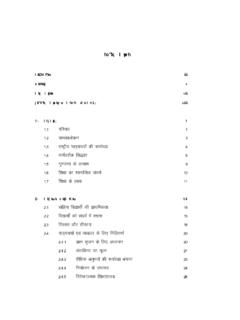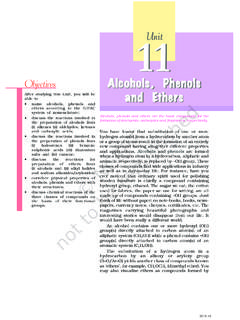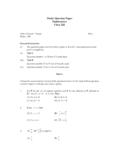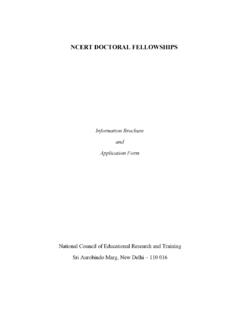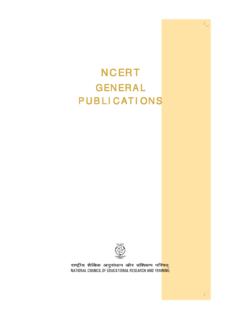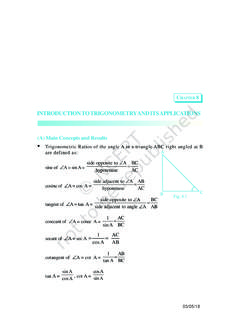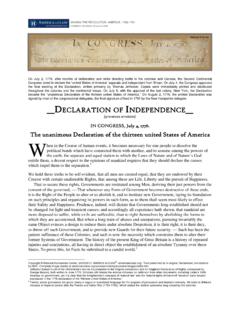Transcription of Integral ch 7 - NCERT
1 INTEGRALS 287vJust as a mountaineer climbs a mountain because it is there, soa good mathematics student studies new material becauseit is there. JAMES B. BRISTOL IntroductionDifferential Calculus is centred on the concept of thederivative. The original motivation for the derivative wasthe problem of defining tangent lines to the graphs offunctions and calculating the slope of such lines. IntegralCalculus is motivated by the problem of defining andcalculating the area of the region bounded by the graph ofthe a function f is differentiable in an interval I, , itsderivative f exists at each point of I, then a natural questionarises that given f at each point of I, can we determinethe function? The functions that could possibly have givenfunction as a derivative are called anti derivatives (orprimitive) of the function.
2 Further, the formula that givesall these anti derivatives is called the indefinite Integral of the function and suchprocess of finding anti derivatives is called integration. Such type of problems arise inmany practical situations. For instance, if we know the instantaneous velocity of anobject at any instant, then there arises a natural question, , can we determine theposition of the object at any instant? There are several such practical and theoreticalsituations where the process of integration is involved. The development of integralcalculus arises out of the efforts of solving the problems of the following types:(a)the problem of finding a function whenever its derivative is given,(b)the problem of finding the area bounded by the graph of a function under two problems lead to the two forms of the integrals, , indefinite anddefinite integrals, which together constitute the Integral .
3 W. Leibnitz(1646-1716)288 MATHEMATICST here is a connection, known as the Fundamental Theorem of Calculus, betweenindefinite Integral and definite Integral which makes the definite Integral as a practicaltool for science and engineering. The definite Integral is also used to solve many interestingproblems from various disciplines like economics, finance and this Chapter, we shall confine ourselves to the study of indefinite and definiteintegrals and their elementary properties including some techniques of Integration as an Inverse Process of DifferentiationIntegration is the inverse process of differentiation. Instead of differentiating a function,we are given the derivative of a function and asked to find its primitive, , the originalfunction. Such a process is called integration or anti us consider the following examples:We know that(sin )dxdx =cos (1)3()3dxdx = (2)and( )xdedx= (3)We observe that in (1), the function cos x is the derived function of sin x.
4 We saythat sin x is an anti derivative (or an Integral ) of cos x. Similarly, in (2) and (3), 33x andex are the anti derivatives (or integrals) of x2 and ex, respectively. Again, we note thatfor any real number C, treated as constant function, its derivative is zero and hence, wecan write (1), (2) and (3) as follows :(sin+ C) cos=dxxdx, 32(+ C )3=dxxdxand (+ C)=xxdeedxThus, anti derivatives (or integrals) of the above cited functions are not , there exist infinitely many anti derivatives of each of these functions whichcan be obtained by choosing C arbitrarily from the set of real numbers. For this reasonC is customarily referred to as arbitrary constant. In fact, C is the parameter byvarying which one gets different anti derivatives (or integrals) of the given generally, if there is a function F such that F ( ) =( )dxf xdx, x I (interval),then for any arbitrary real number C, (also called constant of integration)[]F ( ) + Cdxdx =f(x), x IINTEGRALS 289 Thus,{F + C, C R} denotes a family of anti derivatives of Functions with same derivatives differ by a constant.
5 To show this, let g and hbe two functions having the same derivatives on an interval the function f = g h defined by f(x) = g(x) h(x), x IThendfdx=f = g h giving f (x) = g (x) h (x) x Iorf (x) =0, x I by hypothesis, , the rate of change of f with respect to x is zero on I and hence f is view of the above remark, it is justified to infer that the family {F + C, C R}provides all possible anti derivatives of introduce a new symbol, namely, ( )f x dx which will represent the entireclass of anti derivatives read as the indefinite Integral of f with respect to , we write ( )= F ( ) + Cf x dxx .Notation Given that ( )dyf xdx=, we write y = ( )f x dx .For the sake of convenience, we mention below the following symbols/terms/phraseswith their meanings as given in the Table ( ).Table ( )f x dx Integral of f with respect to xf(x) in ( )f x dx Integrandx in ( )f x dx Variable of integrationIntegrateFind the integralAn Integral of fA function F such thatF (x) = f (x)IntegrationThe process of finding the integralConstant of IntegrationAny real number C, considered asconstant function290 MATHEMATICSWe already know the formulae for the derivatives of many important these formulae, we can write down immediately the corresponding formulae(referred to as standard formulae) for the integrals of these functions, as listed belowwhich will be used to find integrals of other (Anti derivatives)(i)11nndxxdx n+ = + ;1C1nnxx dxn+=++ , n 1 Particularly, we note that( )1dxdx= ; Cdxx= + (ii)()sincosdxxdx= ;cossi nCx dxx=+ (iii)() cossindxxdx= ;sincosCx dx x=+ (iv)()2tansecdxxdx=.
6 2sectanCx dxx=+ (v)()2 cotcosecdxxdx= ;2coseccotCx dx x=+ (vi)()secsectandxxxdx= ;sec tansecCxx dxx=+ (vii)() coseccosec cotdxxxdx= ;cosec cot cosecCxx dxx=+ (viii)() 121sin1dxdx x= ; 12sinC1dxx x=+ (ix)() 121 cos1dxdx x= ; 12cosC1dx x x=+ (x)() 121tan1dxdxx=+ ; 12tanC1dxxx=++ (xi)() 121 cot1dxdxx=+ ; 12cotC1dx xx=++ INTEGRALS 291(xii)() 121sec1dxdxx x = ; 12secC1dxxx x =+ (xiii)() 121 cosec1dxdxx x = ; 12cosecC1dx xx x =+ (xiv)( )xxdeedx= ;Cxxe dxe=+ (xv)()1log | |dxdxx=;1log | | Cdxxx=+ (xvi)xxdaadx log a = ;Cxxaa dxlog a=+ ANote In practice, we normally do not mention the interval over which the variousfunctions are defined. However, in any specific problem one has to keep it in Geometrical interpretation of indefinite integralLet f(x) = 2x. Then 2( )Cf x dxx=+ . For different values of C, we get differentintegrals.
7 But these integrals are very similar , y = x2 + C, where C is arbitrary constant, represents a family of integrals. Byassigning different values to C, we get different members of the family. These togetherconstitute the indefinite Integral . In this case, each Integral represents a parabola withits axis along , for C = 0, we obtain y = x2, a parabola with its vertex on the origin. Thecurve y = x2 + 1 for C = 1 is obtained by shifting the parabola y = x2 one unit alongy-axis in positive direction. For C = 1, y = x2 1 is obtained by shifting the parabolay = x2 one unit along y-axis in the negative direction. Thus, for each positive value of C,each parabola of the family has its vertex on the positive side of the y-axis and fornegative values of C, each has its vertex along the negative side of the y-axis. Some ofthese have been shown in the Fig us consider the intersection of all these parabolas by a line x = a.
8 In the Fig ,we have taken a > 0. The same is true when a < 0. If the line x = a intersects theparabolas y = x2, y = x2 + 1, y = x2 + 2, y = x2 1, y = x2 2 at P0, P1, P2, P 1, P 2 etc.,respectively, then dydx at these points equals 2a. This indicates that the tangents to thecurves at these points are parallel. Thus, 2C2C F ( )x dxxx=+= (say), implies that292 MATHEMATICSthe tangents to all the curves y = FC (x), C R, at the points of intersection of thecurves by the line x = a, (a R), are , the following equation (statement)( )F ( ) C(say)f x dxxy=+= ,represents a family of curves. The different values of C will correspond to differentmembers of this family and these members can be obtained by shifting any one of thecurves parallel to itself. This is the geometrical interpretation of indefinite Some properties of indefinite integralIn this sub section, we shall derive some properties of indefinite integrals.
9 (I)The process of differentiation and integration are inverses of each other in thesense of the following results :( )df x dxdx =f(x)and( )f x dx =f(x) + C, where C is any arbitrary 293 Proof Let F be any anti derivative of f, ,F( )dxdx =f(x)Then( )f x dx =F(x) + CTherefore( )df x dxdx =()F ( ) + Cdxdx=F ( ) = ( )dxf xdxSimilarly, we note thatf (x) =( )df xdxand hence( )f x dx =f(x) + Cwhere C is arbitrary constant called constant of integration.(II)Two indefinite integrals with the same derivative lead to the same family ofcurves and so they are Let f and g be two functions such that( )df x dxdx =( )dg x dxdx or( )( )df x dx g x dxdx = 0 Hence( )( )f x dx g x dx =C, where C is any real number (Why?)or( )f x dx = ( )Cg x dx+ So the families of curves {}11( )C , CRf x dx+ and{}22( )C , CRg x dx+ are , in this sense, ( )and( )f x dxg x dx are The equivalence of the families {}11( )+ C ,Cf x dx R and{}22( )+ C ,Cg x dx R is customarily expressed by writing ( )=( )f x dxg x dx ,without mentioning the parameter.
10 (III)[]( ) + ( )( )+( )f xg x dxf x dxg x dx= ProofBy Property (I), we have[ ( ) + ( )]df xg x dxdx =f(x) + g(x).. (1) On the otherhand, we find that( )+( )df x dxg x dxdx =( )+( )ddf x dxg x dxdxdx =f(x) + g(x).. (2) Thus, in view of Property (II), it follows by (1) and (2) that()( )( )f xg xdx+ =( )( )f x dxg x dx+ .(IV) For any real number k, ( )( )k f x dxkf x dx= Proof By the Property (I), ( )( )dk f x dxk f xdx= .Also( )dkf x dxdx = ( )=( )dkf x dxk f xdx Therefore, using the Property (II), we have ( )( )k f x dxkf x dx= .(V)Properties (III) and (IV) can be generalised to a finite number of functionsf1, f2, .., fn and the real numbers, k1, k2, .., kn giving[]1 12 2( )( )( )n nk f xk f k f x dx+++ = 1122( )( )( )nnkf x dx kfx kf x dx+++.

